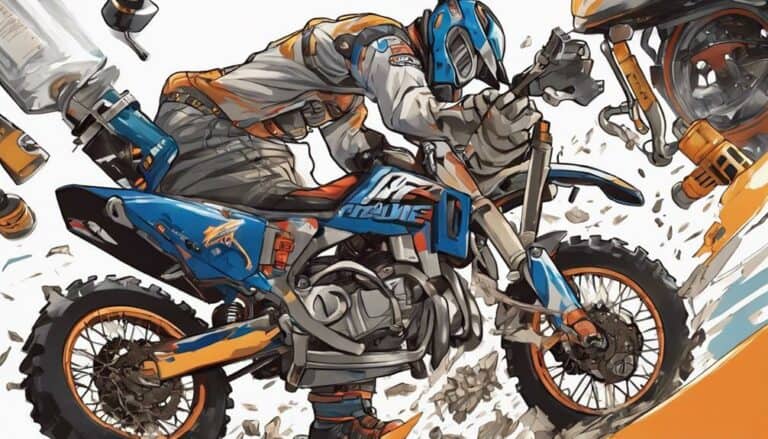If your Razor dirt bike is struggling to crank up, did you know that nearly 70% of starting issues are related to battery or electrical problems? Before you get frustrated and give up on your ride, there are some key steps you can take to troubleshoot and resolve the issue.
From checking the fuel system to evaluating the carburetor, each component plays an essential role in getting your bike up and running smoothly. Stay tuned to discover the vital tips to make sure your Razor dirt bike cranks up effortlessly and gets you back on the trail in no time.
Key Takeaways
- Check fuel system for blockages, leaks, and proper fuel type.
- Inspect spark plug for fouling, adjust gap, and clean electrodes.
- Ensure air filter is clean and unobstructed for optimal airflow.
- Test battery voltage, load, and connections to support motor operation.
Check the Fuel System
To guarantee your Razor dirt bike cranks up smoothly, thoroughly inspect the fuel system for any issues that may impede proper engine performance.
Start by checking the fuel tank to make sure it contains the correct type of gasoline recommended for your bike.
Next, evaluate the fuel lines for blockages, leaks, or damage that could hinder fuel flow to the engine.
A clog in the fuel filter can restrict the fuel supply, so make sure to check and replace the filter if needed.
Additionally, cleaning the carburetor is important to make sure it's free of dirt or any faults that could prevent the engine from starting efficiently.
Inspect the Spark Plug
After thoroughly inspecting the fuel system of your Razor dirt bike, the next step is to remove the spark plug using a spark plug wrench to check its condition for fouling or damage. Spark plug troubleshooting is important for proper ignition system diagnosis.
Once the spark plug is removed, examine the electrode and insulator for any signs of fouling, such as black sooty deposits or oil buildup. Use a gapping tool to make sure the spark plug gap falls within the manufacturer's specifications; adjust if necessary. Clean the spark plug electrodes using a wire brush to eliminate any carbon deposits or dirt that could hinder spark ignition.
If the spark plug shows wear, damage, or fails to produce a strong spark when tested, it's time for a replacement. Choose a suitable replacement spark plug based on the manufacturer's recommendations. Reinstall the spark plug firmly into the engine cylinder to guarantee a secure connection and reliable ignition. A well-maintained spark plug is essential for best engine performance and starting reliability.
Examine the Air Filter
Inspecting the air filter cover on the side of your Razor dirt bike allows you to assess the condition of the air filter for any restrictions to airflow. Proper air filter maintenance is vital for best engine performance and starting capabilities.
Start by removing the air filter cover to access the air filter itself. Look for any dirt, debris, or clogs that may be impeding airflow to the engine. If the air filter is dirty, clean it using compressed air or a mixture of soap and water. Make sure the filter is completely dry before reinstalling it.
If the air filter is damaged or excessively dirty, it's advisable to replace it to maintain proper air intake for the engine. By keeping your air filter clean and functioning correctly, you not only ensure the longevity of your engine but also pave the way for potential performance upgrades down the line.
Test the Battery
When testing the battery on your Razor dirt bike, make sure the voltage measures above 20.5 volts for best controller functionality. Using a multimeter, check the voltage to confirm the batteries are providing sufficient power for the bike to start smoothly.
Here are some steps to think about when testing the battery:
- Load Test: Test the batteries under load to identify any significant voltage drop, indicating potential power delivery issues.
- Inspect Connections: Examine the battery connections and terminals for corrosion or loose connections that could hinder power flow.
- Amperage Check: Make sure the batteries are supplying enough amperage to operate the motor effectively, preventing starting problems.
Regular battery maintenance is important for top dirt bike performance. If the batteries fail to hold a charge or reveal voltage drop during use, replacing them might be necessary. By following these steps, you can make sure your Razor dirt bike is powered up and ready for action.
Evaluate the Carburetor
To evaluate the carburetor on your Razor dirt bike, carefully examine for any signs of clogs, dirt, or damage that could impede fuel flow to the engine. Proper carburetor maintenance is vital to guarantee peak performance. Below is a table outlining key steps for fuel flow analysis and carburetor maintenance:
| Carburetor Evaluation Steps | Description | Action Required |
|---|---|---|
| Inspect for Clogs | Check for any blockages hindering fuel flow. | Clean carburetor with carburetor cleaner. |
| Check for Dirt | Look for dirt accumulation affecting performance. | Use compressed air to remove any dirt residue. |
| Assess for Damage | Identify any physical damage to the carburetor. | Consider replacing damaged components. |
| Verify Adjustment Screws | Ensure correct settings for fuel and air mixture. | Adjust screws to manufacturer specifications. |
Conclusion
To summarize, ensuring the proper functioning of key components like the fuel system, spark plug, air filter, battery, and carburetor is essential to make your Razor dirt bike crank up smoothly.
Just like a well-oiled machine, regular maintenance and troubleshooting will keep your bike running like a finely tuned instrument, ready to tackle any terrain with ease.

